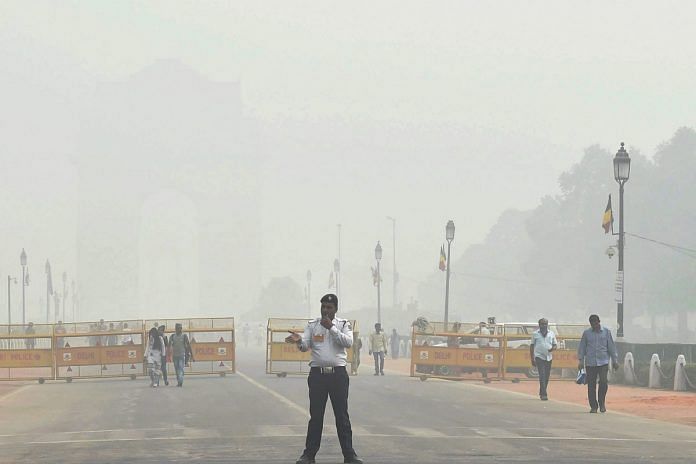Congress’s Ajay Maken blames AAP government’s inaction on public transport for smog, while Chief Minister Arvind Kejriwal goes on the defensive.
The air quality in the National Capital Region plummeted to its worst levels of the season Tuesday, forcing the Indian Medical Association to declare a public health emergency.
But as the crisis also laid bare the lack of action by the governments of Delhi and its neighbouring states to address the causes, political leaders resorted a familiar blame-game.
While senior Congress leader Ajay Maken hit out at the Aam Aadmi Party government in the city-state for the worsening situation, Chief Minister Arvind Kejriwal went on the defensive, blamed neighbouring states, and asked for all concerned to come together to combat the menace of smog.
With the PM 2.5 levels recorded at R.K. Puram in south Delhi and Punjabi Bagh in west Delhi were 652 and 763 respectively Tuesday morning, Deputy CM Manish Sisodia called a meeting with the education, health, and environment departments, to tackle the emergency.
Who said what
Maken said the smog that had enveloped the city was due to the deterioration in Delhi’s public transport infrastructure.
“Unfortunately, instead of the public transport system being improved, it has deteriorated. In 2013, we had 5,500 DTC buses, which have come down to 3,600 now. Despite the loss of 1,900 buses, there hasn’t been a purchase of single bus till now by this government,” Maken said.
“The third phase of the Delhi Metro was to be completed by September 2016. It is now November 2017, and even now, only 22 kilometres out of the total plan of 159 kilometres of the third phase have been completed.”
Kejriwal, on the other hand, tweeted: “Delhi has become a gas chamber. Every year this happens during this part of year. We have to find a soln [solution] to crop burning in adjoining states.”
He added: “Delhi govt wrote letters to adjoining states in Aug urging them to take steps to check crop burning.”
Sisodia, for his part, asked the Centre to intervene to help curb stubble burning, and added “at most, we can work with water [to try and settle road dust]”.
“We will contemplate shutting down schools, as well as issuing a health advisory, but we are waiting for the pollution department and the health department to give us the report first. We will have a meeting in the evening and hopefully find solutions,” he said.
After a meeting with Arvind Kejriwal, Sisodia said primary schools will remain shut on Wednesday. He also said that if need arose, the government is ready to implement the Graded Action Plan formulated by the Environment Pollution (Prevention & Control) Authority.
Experts’ view
The Environment Pollution (Prevention & Control) Authority recommended a graded action plan in April this year, which is supposed to kick in every time PM 2.5 levels cross 300 µg/m3. It includes barring the entry of trucks into Delhi, and introducing the ‘odd-even’ scheme. The plan also directs the deployment of a special task force for taking special steps such as shutting schools down.
But the Delhi government is yet to take any of these decisions.
“It takes two or three days for the smoke from stubble burning to reach Delhi. We saw that stubble burning was very high between 3-5 November. So that has possibly led to the spike in PM2.5 figures right now,” said Shambhavi Shukla, research associate on clean air at the Centre for Science and Environment.
However, Shukla explained that it is not just stubble burning that is contributing to the plummeting air quality and smog. “There is no enforcement on the issue of waste burning in the city. Even the landfill sites in Delhi are continuously burning,” she said.
“Stubble burning only happens for a certain time but after that, it’s Delhi’s own sources that cause the rise of pollution. Our own private vehicles are continuously increasing, which contributes to the overall increase in pollution. The transport sector contributes to 21 per cent of PM 2.5 in Delhi. Illegal parking and waste burning should also be banned.”
Shukla stressed the need for increasing public transport, especially in the case of public buses, as pointed out by Maken.
Doctors reiterated health warnings, with paediatrician Sunil Mehra pointing out that there had been a significant increase in obstructive airway diseases in children in the past 25-30 years.
“From two out of 10 children with problems 10 years ago, the number has risen to six out of 10 at this time of the year,” he said. “This has long-term consequences for children’s overall growth, so we need to be careful that airways do not stay obstructed for too long.”
This article was updated to include information about primary schools staying shut on Wednesday.






